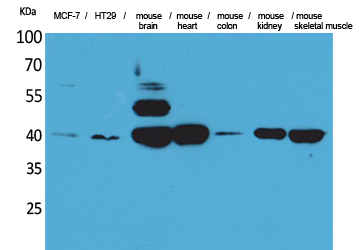IDH3A Polyclonal Antibody
- Catalog No.:YT5318
- Applications:WB;IHC;IF;ELISA
- Reactivity:Human;Mouse;Rat
- Target:
- IDH3A
- Fields:
- >>Citrate cycle (TCA cycle);>>Metabolic pathways;>>Carbon metabolism;>>2-Oxocarboxylic acid metabolism;>>Biosynthesis of amino acids
- Gene Name:
- IDH3A
- Protein Name:
- Isocitrate dehydrogenase [NAD] subunit alpha mitochondrial
- Human Gene Id:
- 3419
- Human Swiss Prot No:
- P50213
- Mouse Gene Id:
- 67834
- Mouse Swiss Prot No:
- Q9D6R2
- Rat Gene Id:
- 114096
- Rat Swiss Prot No:
- Q99NA5
- Immunogen:
- Synthesized peptide derived from the Internal region of human IDH3A.
- Specificity:
- IDH3A Polyclonal Antibody detects endogenous levels of IDH3A protein.
- Formulation:
- Liquid in PBS containing 50% glycerol, 0.5% BSA and 0.02% sodium azide.
- Source:
- Polyclonal, Rabbit,IgG
- Dilution:
- WB 1:500 - 1:2000. IHC: 1:100-1:300. ELISA: 1:20000.. IF 1:50-200
- Purification:
- The antibody was affinity-purified from rabbit antiserum by affinity-chromatography using epitope-specific immunogen.
- Concentration:
- 1 mg/ml
- Storage Stability:
- -15°C to -25°C/1 year(Do not lower than -25°C)
- Other Name:
- IDH3A;Isocitrate dehydrogenase [NAD] subunit alpha, mitochondrial;Isocitric dehydrogenase subunit alpha;NAD(+)-specific ICDH subunit alpha
- Observed Band(KD):
- 39kD
- Background:
- Isocitrate dehydrogenases catalyze the oxidative decarboxylation of isocitrate to 2-oxoglutarate. These enzymes belong to two distinct subclasses, one of which utilizes NAD(+) as the electron acceptor and the other NADP(+). Five isocitrate dehydrogenases have been reported: three NAD(+)-dependent isocitrate dehydrogenases, which localize to the mitochondrial matrix, and two NADP(+)-dependent isocitrate dehydrogenases, one of which is mitochondrial and the other predominantly cytosolic. NAD(+)-dependent isocitrate dehydrogenases catalyze the allosterically regulated rate-limiting step of the tricarboxylic acid cycle. Each isozyme is a heterotetramer that is composed of two alpha subunits, one beta subunit, and one gamma subunit. The protein encoded by this gene is the alpha subunit of one isozyme of NAD(+)-dependent isocitrate dehydrogenase. [provided by RefSeq, Jul 2008],
- Function:
- catalytic activity:Isocitrate + NAD(+) = 2-oxoglutarate + CO(2) + NADH.,cofactor:Binds 1 magnesium or manganese ion per subunit.,similarity:Belongs to the isocitrate and isopropylmalate dehydrogenases family.,subunit:Heterooligomer of subunits alpha, beta, and gamma in the apparent ratio of 2:1:1.,
- Subcellular Location:
- Mitochondrion.
- Expression:
- Brain,Brain cortex,Cajal-Retzius cell,Esophagus tumor,Fetal
Effect of IDH3a on glucose uptake in lung adenocarcinoma: A pilot study based on [18F]FDG. Cancer Medicine 2019 Jul 29 WB Human 1:500 A549 cell, H1299 cell
- June 19-2018
- WESTERN IMMUNOBLOTTING PROTOCOL
- June 19-2018
- IMMUNOHISTOCHEMISTRY-PARAFFIN PROTOCOL
- June 19-2018
- IMMUNOFLUORESCENCE PROTOCOL
- September 08-2020
- FLOW-CYTOMEYRT-PROTOCOL
- May 20-2022
- Cell-Based ELISA│解您多样本WB检测之困扰
- July 13-2018
- CELL-BASED-ELISA-PROTOCOL-FOR-ACETYL-PROTEIN
- July 13-2018
- CELL-BASED-ELISA-PROTOCOL-FOR-PHOSPHO-PROTEIN
- July 13-2018
- Antibody-FAQs
- Products Images

- Western Blot analysis of MCF-7, HT29, mouse brain, mouse heart, mouse colon, mouse kidney, mouse skeletal muscle cells using IDH3A Polyclonal Antibody. Secondary antibody(catalog#:RS0002) was diluted at 1:20000

- Immunohistochemical analysis of paraffin-embedded human-lymph-gland, antibody was diluted at 1:100



